The department was established in 1975 under the leadership of NASU academician B.G. Lazarev, who created a world famous school in the field of solid state physics and cryogenics. The future academicians of NASU B.I. Verkin, A.A. Galkin, I.M. Dmytrenko, I.M. Neklyudov, member-corr. of NASU V.I. Khotkevich, academicians of RAS N.E. Alekseevskiy and L.F. Vereshchagin worked in the laboratories that became part of the department. Under the leadership of prof. L.V. Shubnikov in the 1930s, for the first time in the USSR, hydrogen and helium were liquefied, and superconductivity of the second kind was discovered. B.G. Lazarev is a laureate of USSR State Award (1951) and Ukrainian State Award (1982). Laureates of Ukrainian State Award, former employees of the department, are I.A. Gindin (1980), L.S. Lazarev and V.A. Poltavets (1982).
The department includes 3 research laboratories and employs 3 Doctors of Sciences and 9 PhDs.
The total number of publications is more than 1500, including 3 monographs, more than 70 patents; 3 international and 1 industry conferences were organized; 42 theses were defended. Click here to see the list of publications.
Main directions of work
Experimental and theoretical investigations on the changes in the properties and structure of the structural and functional materials under the influence of temperature-force, radiation, magnetic and electric fields are carried out in the department for the development of new materials and technologies in nuclear power industry and other fields of technology:
– investigations on the processes of plastic deformation, structure formation, strengthening, softening and destruction of structural materials for reactor engineering and cryogenic technology under the extreme conditions of exposure (large plastic deformations, wide range of temperatures, including low ones, strong magnetic fields, irradiation and their combination) and establishment of correlation between the structural factors, physical and mechanical properties for obtaining the materials with high performance and restoring properties that degraded during operation;
– experimental and theoretical studies at the atomic level of the structure for crystal lattice defects, the processes of their interaction and evolution of structural elements under mechanical, thermal and radiation effects; field ion microscopy studies of quantum objects – atomic chains of carbon and graphene;
– search and study of new physical phenomena that are realized in pure and ultrapure metals and alloys on their basis in order to use them for the development of new technologies in nuclear power engineering and other fields of technology; investigation of the features of electrophysical and magnetic properties in superconducting, normal and magnetically ordered states of metals and alloys with nanoscale structures;
– investigation of adsorption and desorption for various gaseous substances, including gaseous fission products of nuclear fuel and hydrogen, functional and structural materials; study of the properties of coal sorbents on the market for their use in the manufacture and repair of iodine filters for the ventilation system of NPPs.
Major achievements
Research on the physics of strength
Nanostructured materials (austenitic steels, Zr, Ti, Nb and alloys) with high performance (exceeding those obtained with the traditional treatment) were obtained by the unique methods of severe plastic deformation at cryogenic temperatures (quasihydroextrusion (QHE), rolling and drawing). Reasonability for sequential combination of pressure treatments with different stress distributions in order to achieve a high level of hardening without disrupting the material continuity is experimentally substantiated.
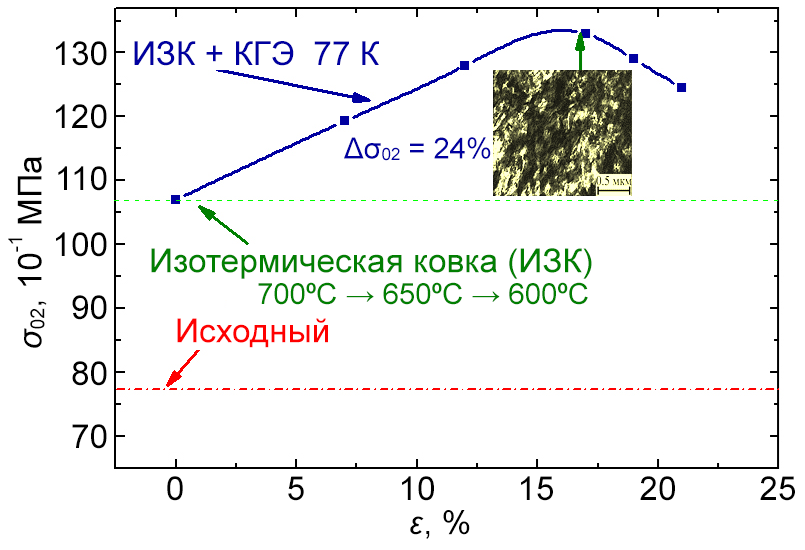
Dependence of the yield strength for the VT6 alloy on the degree of deformation by quasihydroextrusion at 77 K after isothermal forging
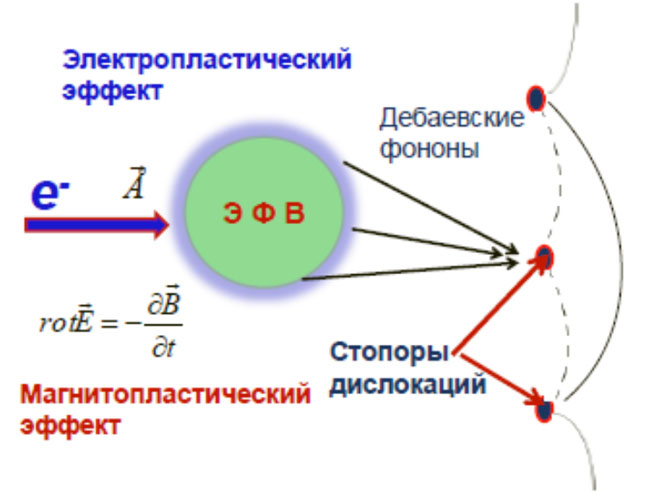
For magnetically ordered metals, the unified nature of magnetoplastic (under the action of alternating magnetic field (MF)) and electroplastic (under the action of electric field (EF)) effects was determined theoretically and experimentally. The nature lies in metal softening due to the detachment of dislocations from stoppers due to short-wave (Debye) phonons, electrons generated as a result of electron-phonon interaction (EPI), which received energy from the electric field (induction under the MF effect) (jointly with IPENMA).
Methods of relaxation energy effects (ultrasound, non-stationary magnetic fields) were developed as applied to materials and welded joints of NPP equipment:
– as a result of ultrasonic action, the nanostructured Zr1Nb alloy obtained by the combined intense deformation at 77 and 300 K, in comparison with the recrystallized state, has higher creep resistance and strength level with the sufficient plasticity level at the operating temperature of the fuel element claddings;
– the effect of alternating magnetic field of industrial frequency in a certain mode leads to a significant decrease in the effects of radiation and strain hardening, as well as of thermal macrostresses in 15Kh2NMFA hull steel and its welded joints.
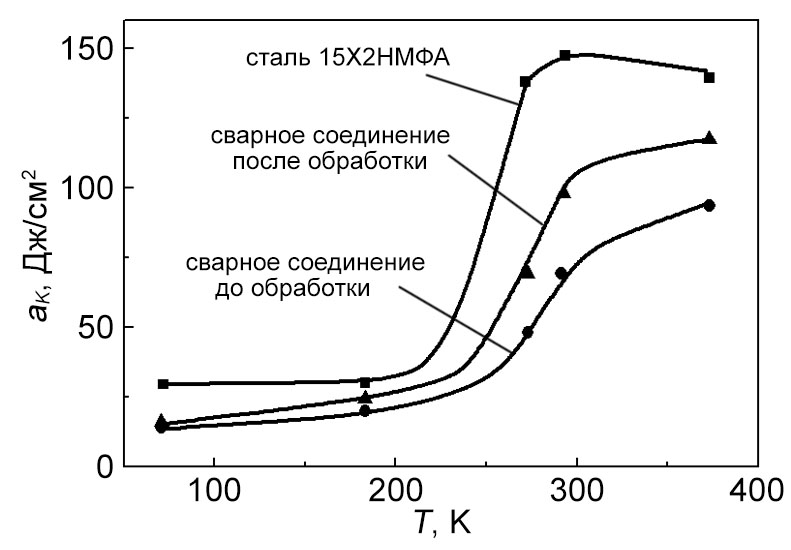
Temperature dependences of shock viscosity aK
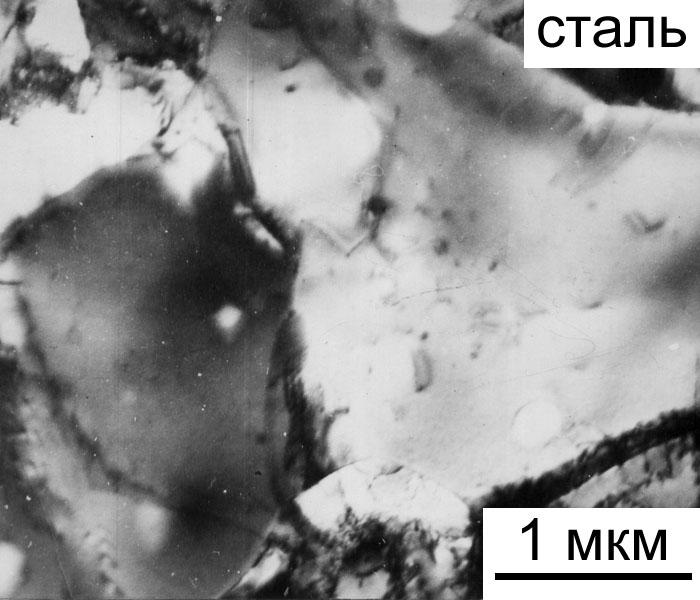
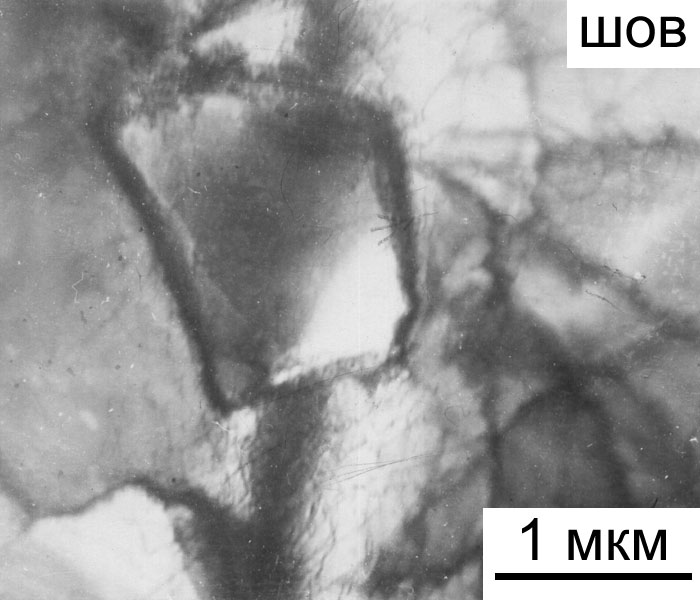
before magnetic treatment
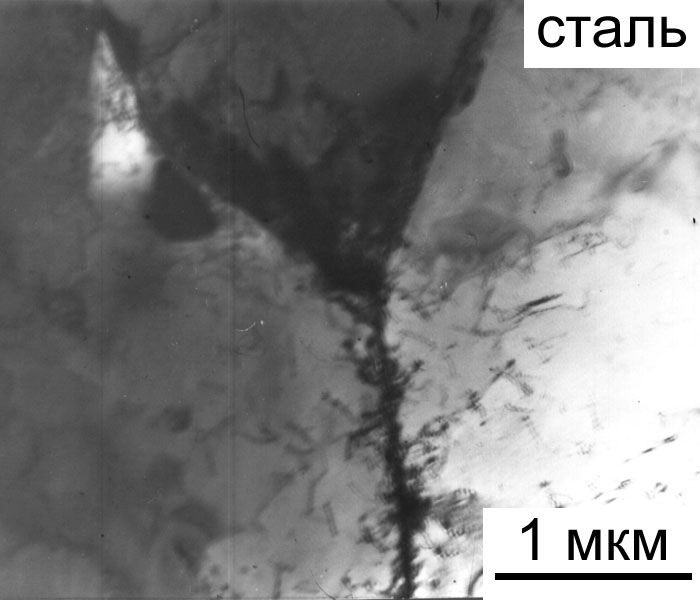
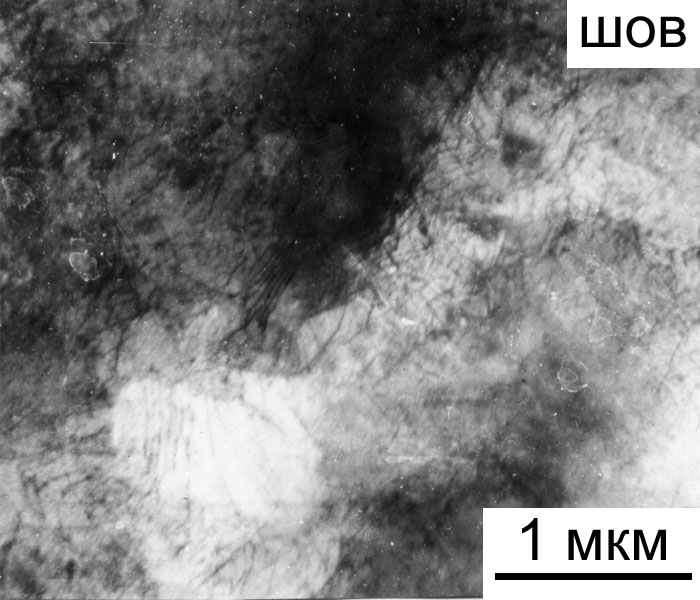
after magnetic treatment
Structure of the welded joint (steel in the viscinity of the weld seam and the seam itself) for the 15Kh2NMFA steel before and after magnetic treatment
Study of the fine structure and properties for micro-, nano- and pico-sized materials using the field emission microscopy and mathematical modeling
The strength of carbon monatomic chains was determined experimentally and theoretically. By the method of high-field loading with electric field, it was found that the maximum experimental value for the strength of carbon chains at 5 K is 270 GPa, which corresponds to 90% of the theoretical value for the strength of ideal carbon chain. This value exceeds the strength of all known materials, including carbon nanotubes and graphene.
The change in the increase of resolution for the cryogenic field ion microscope at the decrease in the size of the samples in nano- and subnanometer ranges was studied experimentally and theoretically. The existence of anomalous increase in the field ion images and improvement in the resolution limits to 0.40 ± 0.05 Å was determined..
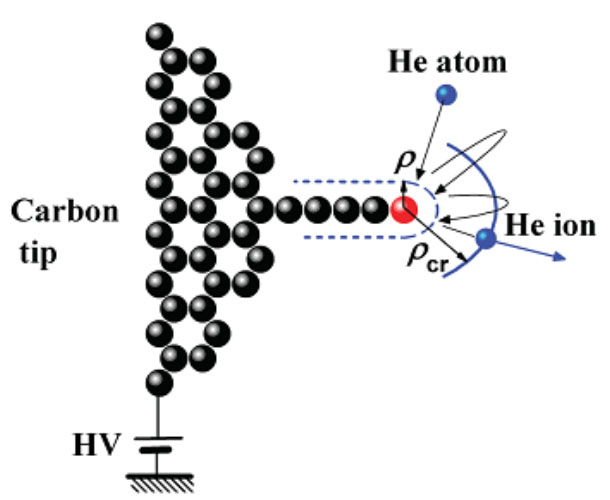
Schematic diagram for helium field ionization at the top of monoatomic carbon chain
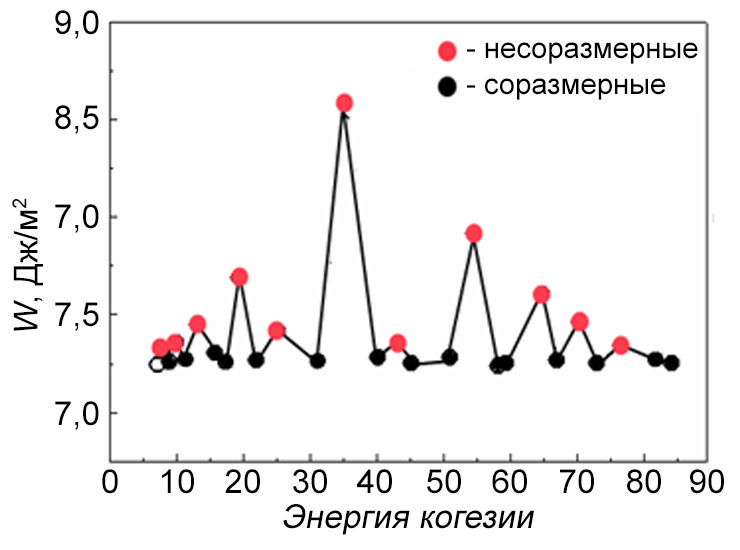
Cohesion energy of special disproportionate grains depending on the misorientation angle
A new class of asymmetric specific grain boundaries that cannot be described by the traditional theory of coincidence site lattices (CSL) was revealed by the method of field ion microscopy and mathematical modeling. It was determined that such specific non-CSL boundaries have high cohesive strength, close to theoretical, and dominate in the spectrum of boundaries for cold-drawn highly textured tungsten. The results obtained can be used in grain boundary engineering of high-strength and radiation-resistant polycrystalline functional and structural materials for reactor engineering.
The phenomenon of long-range interaction of the surface atoms of radiation origin with their own interstitial atoms in the near-surface layers was found by the methods of low-temperature field ion microscopy. It was found that during tungsten irradiation with helium atoms, as a result of this interaction, loose-packed 2D clusters of adatoms appear, and 1D surface chains with the interatomic distance of ≈ 1 nm (marked with pink arrows) are self-consistently formed. A new collective mechanism of radiation-stimulated surface diffusion was determined, including the formation of linearly delocalized vacancies – voidions (dashed line in the diagram) in the surface layer; adatom that appered during irradiation is marked in red.
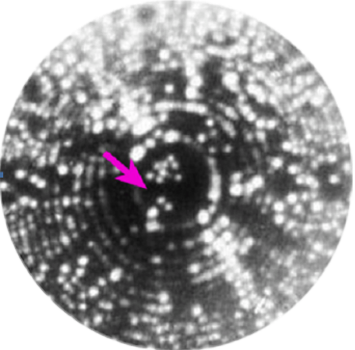
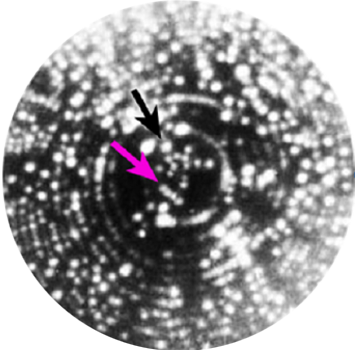
Formation of adatom linear chains as a result of long-range interaction
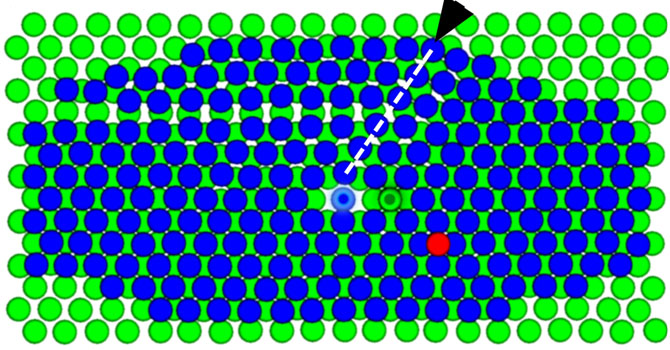
Voidion movement scheme
Development of ideas on the nature of high-temperature superconductors
Using the developed original method of electronic subsystem plane-contact probing, for the first time, a large-scale hole-electron conversion of charge carriers was discovered before the transition of cuprate HTSCs to the superconducting state (a sharp drop in the electrical resistance, point 4 in the figure), which shows the electronic-topological Lifshitz transition associated with the achievement of 2D-3D crossover temperature (HTSC trimerization temperatures).
For the first time, convincing experimental evidence was obtained for the existence of positively charged local pairs (LP) in the pseudogap state of HTSCs, the concept of which comes from the Hubbard model. The existence of several stages for the pseudogap temperature evolution is established, and the decrease in HTSC thermal conductivity due to LP is shown.
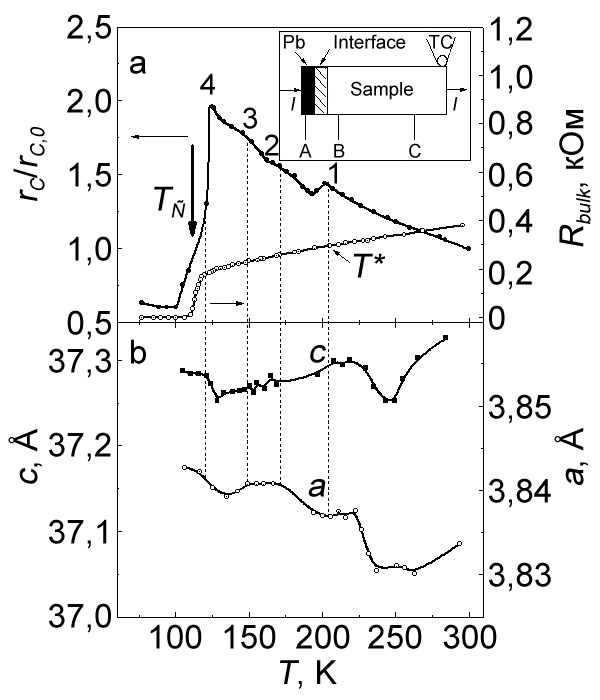
Temperature dependences: а − the HTSC Bi1.6(Pb0.4)Sr2Ca2Cu3O10+x electrical resistance (lower curve) and HTSC/Pb interface (upper curve); b − the HTSC crystal lattice parameters
Precision acoustic studies of crystalline and amorphous materials
In the temperature range of 77-300 K, the elastic, vibrational and dissipative characteristics of bulk metallic glasses (BMG) were measured: Zr41.2Ti13.8Cu12.5Ni10Be22.5, Zr52.5Ti5Cu17.9Ni14.6Al10 and (Zr55Al10Ni5Cu30)99Y1. It is shown that the difference in the elastic moduli and the Debye temperature of BMG with Be and Al corresponds to the difference in sizes of the average ordered region in the efficient cluster packing model. The established features of ultrasound absorption are associated with the intensification of relaxation processes for the migrations of atom clusters at the intercluster boundaries as a result of the action of thermal fluctuations and alternating ultrasonic stresses.
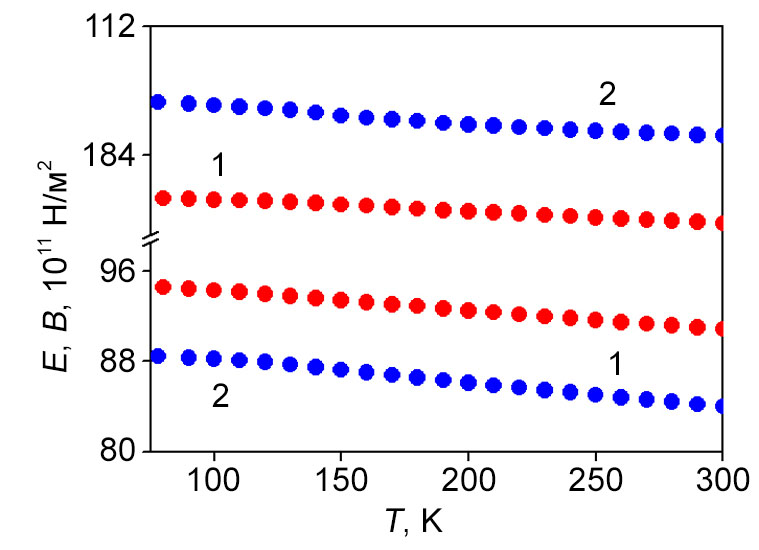
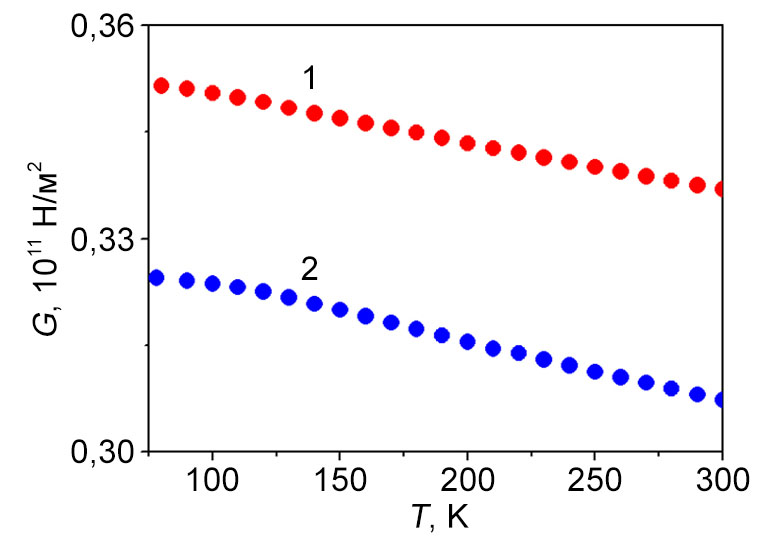
Temperature dependence of the elastic moduli in bulk metal glasses Zr41.2Ti13.8Cu12.5Ni10Be22.5 (1) and Zr52.5Ti5Cu17.9Ni14.6Al10 (2)
Acoustic research for high-purity HCP metals (Cd -> 99.999%, Hf – zone-melted) was carried out. In Cd, a first-order isotope effect (linear dependence on the difference in isotope masses) was found for the speed of sound, which shows the influence of isotopic composition on the change in the phonon spectrum; for ultrasound attenuation, a second-order effect associated with the nonuniform distribution of isotopes and additional relaxation mechanism of phonon scattering was found. In a single Hf crystal, the independent adiabatic constants of the elasticity tensor с11 and с33 were determined and their increase was shown together with the decrease in the dislocation density. It was found that the resonance and relaxation features in the behavior of ultrasound absorption in hafnium were caused by the oscillations of dislocation segments in the "valley" of the Peierls potential relief and by overcoming this relief.
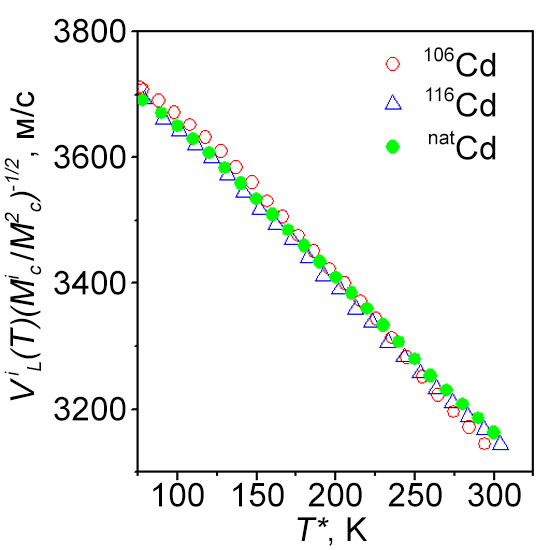
The universal ratio for the reduced velocity of longitudinal ultrasound versus the reduced temperature T*=T(MiC/M2C)1/2 for Cd isotopes
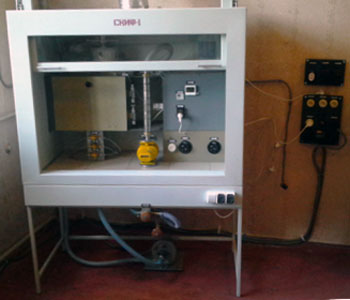
The pumping module "SKIF-1" is used for controlled saturation of the studied sorbent layers with methyl iodide/iodine admixture along the height of the adsorber experimental model at the given temperature, humidity and concentration of impurity vapors in the air flow
Investigation of carbon sorbents for NPP air filters
The SKIF-1 module was manufactured for pumping the air flow with iodine/methyl iodide admixture through the adsorber experimental model with carbon sorbent, and the method for measuring the absorption of these impurities under the conditions simulating the operation of AU-1500 adsorbers used at Ukrainian NPPs was developed.
The adsorption, aerodynamic and mechanical properties for a number of coal sorbents produced in Ukraine, Germany and Holland were studied, which made it possible to select sorbents with optimal performance characteristics. Taking into account the results of these studies, more than 200 adsorbers were repaired and manufactured by JV “Atomenergomash” of NNEGC “Energoatom”.
Department structure
– Laboratory of Fundamental and Applied Superconductivity, Electronic Properties of Metals.
Investigations on the electronic processes and electronic-phase state of new alloys, metals and superconductors depending on the composition and structural state.
– Laboratory of Physics of Strength and Plasticity.
Investigation of submicron and nanometer structure formation in structural materials for reactor and cryogenic engineering by the methods of combined severe plastic deformations, study of relaxation processes in deformed and irradiated materials, welded joints when exposed to ultrasound and non-stationary magnetic fields; establishing the connection between the structural factors, physical and mechanical properties to determine the regimes of exposure that provide high-level properties for the practical use of materials; studies of adsorption and desorption for various gaseous substances (including gaseous fission products of nuclear fuel and hydrogen) in the functional and structural materials, corresponding changes in their physical and mechanical properties.
– Laboratory of Crystal Physics.
Investigation of the atomic structure and interaction of lattice defects in solids and quantum objects (atomic chains of carbon and graphene) using high-resolution low-temperature field ion microscopy and mathematical modeling; ultrasonic studies of the temperature dependence for linear acoustic characteristics (velocity and absorption of ultrasound) of metals and alloys.
Publications
| 1. | С.І. Лавров, В.В. Левенець, В.І. Соколенко. Сертифікація вугільних сорбентів йодних фільтрів систем вентиляції АЕС. Монографія. Харків: Видавництвово «Зебра». 2019, 274 с. |
|---|---|
| 2. | В.А. Белоус, В.И. Соколенко, А.А. Чупиков, А.С. Куприн, О.П. Леденев, В.Д. Овчаренко. Теплофизические свойства оболочек твэлов с различными вакуумно-дуговыми покрытиями. ВАНТ. Серия «Физика радиационных повреждений и явлений в твёрдых телах». 2019, №2(120), с. 99 – 103. |
| 3. | В.И. Карась, В.И. Соколенко. Неравновесная кинетика электрон-фононной подсистемы кристалла при действии переменных электрических и магнитных полей как основа электро- и магнитопластического эффектов. Успехи физических наук. 2018, т. 188, №11, с. 1155 – 1177. |
| 4. | В.И. Соколенко, В.М. Горбатенко. Влияние магниторешеточных превращений на низкотемпературную пластичность и разрушение монокристаллов хрома. ФНТ. 2018, т. 44, №9, c. 1218 – 1226. |
| 5. | А.С. Булатов, Г.П. Ковтун, В.С. Клочко, А.В. Корниец, Д.А. Солопихин. Скорость и затухание продольного ультразвука в изотопически обогащенном кадмии. Металлофизика и новейшие технологии. 2018, т. 40, №11, с. 637 – 647. |
| 6. | П.А. Хаймович. Криодеформирование металлов в условиях всестороннего сжатия (обзор). ФНТ. 2018, т. 44, №5, с. 463 – 490. |
| 7. | V.I. Karas, E.V. Karasyova, A.V. Mats, V.I. Sokolenko, A.M. Vlasenko, V.E. Zakharov. Influence of Alternating Magnetic Field on Physical and Mechanical Properties of Crystals. Металлофиз. новейшие технол. (Metallofiz. Noveishie Tekhnol.) 2016, т. 38, №8, с. 1027 – 1055. |
| 8. | Т.І. Mazilova, E.V. Sadanov, V.N. Voyevodin, V.A. Ksenofontov, I.M. Mikhailovskij. Impact-induced Concerted Mass Transport on W Surfaces by a Voidion Mechanism. Surface Science. 2018, v. 669, p. 10 – 15. |
| 9. | Е.V. Karaseva, V.I. Sokolenko, V.M. Gorbatenko, A.V. Mats, E.S. Savchuk, V.A. Frolov. Effect of Ultrasonic Impact Treatment on the Creep Characteristics and Evolution of the Zr1Nb Alloy Nanostructure. Functional Matereals. 2018, 25(3), p. 458 – 462. |
| 10. | И.В. Лепин, Т.К. Григорова, В.И. Соколенко. Адсорбционное понижение прочности сорбентов и катализаторов. ВАНТ. Серия «Физика радиационных повреждений и радиационное материаловедение». 2018, №2(114), c. 89 – 93. |
| 11. | О.Е. Кожевников, Н.Н. Пилипенко, А.С. Булатов, П.Н. Вьюгов, В.С. Клочко, А.В. Корниец. Получение и исследование высокочистого моно- и поликристаллического гафния. ВАНТ. Серия «Вакуум, чистые материалы, сверхпроводники». 2018, №1(113), с. 54 – 61. |
| 12. | T.I. Mazilova, E.V. Sadanov, I.M. Mikhailovskij. Long-range Interaction of Radiation-generated Self-interstitial Atoms and Adatoms on Tungsten Surface. Phil. Mag. Let. 2018, 98(7), p. 310 – 318. |
| 13. | О.И. Волчок, В.В. Калиновский, И.В. Лепин, А.В. Пахомов, В.И. Соколенко. Микроперестройки структуры аустенитной стали c остаточным мартенситом в процессе ультразвукового воздействия. ВАНТ. Серия «Физика радиационных повреждений и радиационное материаловедение». 2018, №2(114), с. 19 – 24. |
| 14. | S.O. Kotrechko, I.M. Mikhailovskij, T.I. Mazilova, E.V. Sadanov, A.N. Timoshevskii, N.M. Stetsenko. Mechanical Properties of Carbyne: Experiment and Simulations. Nanoscale Research Letters. 2015, v. 10, No. 24, 6 p. |
| 15. | В.И. Соколенко, В.А. Фролов. Электронно-топологический переход в купратных ВТСП перед сверхпроводящим переходом. Письма в ЖЭТФ. 2017, 105, №10, с. 621 – 623. |
| 16. | В.В. Левенец, В.И. Соколенко, Э.И. Винокуров, А.Ю. Лонин, А.П. Омельник, Р.М. Сибилева, А.А. Щур. Определение коэффициента поглощения йода углеродными материалами адсорберов систем вентиляции АЭС с использованием стабильных изотопов. ВАНТ. Серия «Вакуум, чистые материалы, сверхпроводники». 2016, в. 21, №1(101), с. 56 – 60. |
| 17. | O.V. Dudka, V.A. Ksenofontov, E.V. Sadanov, I.V. Starchenko, T.I. Mazilova, I.M. Mikhailovskij. Special Grain Boundaries in Nanostructured Tungsten. Nanoscale Research Letters. 2016, v. 11, No. 332, 7 р. |
| 18. | Л.А. Чиркина, М.Б. Лазарева, В.И. Соколенко, В.С. Оковит, В.В. Калиновский. Структура и физико-механические cвойства свплава Nb-Ti после различных видов механико-термических воздействий. Успехи физики металлов. 2016, т. 17, с. 343 – 373. |
| 19. | В.В. Калиновский, М.Б. Лазарева, Д.Г. Малыхин, А.В. Мац, В.С. Оковит, В.И. Соколенко, Л.А. Чиркина. Влияние различных видов деформации на физико-механические свойства ГПУ и ГЦК металлов и сплавов. Успехи физики металлов. 2015, т. 16, №1, с. 61 – 84. |
| 20. | С.А. Бакай, А.С. Булатов, В.Ф. Долженко, В.С. Клочко, А.В. Корниец, В.И. Спицына. Низкотемпературные упругие свойства объемных металлических стекол на основе циркония. Металлофизика и новейшие технологии. 2015, т. 37, №5, с. 637 – 647. |
Employees
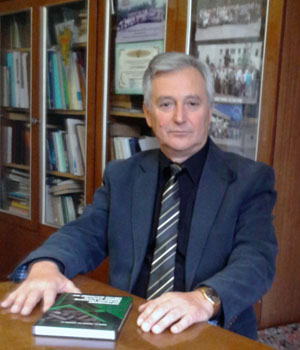
SOKOLENKO VLADIMIR IVANOVICH
Head of department
D.Sci. in Physics and Mathematics by the specialty 01.04.07 – "Solid State Physics"
Senior Researcher
Phone. +38(057) 700-05-71, +38(066)493-52-88
e-mail: vsokol@kipt.kharkov.ua
Research interests:
solid state physics, electronic properties, physics of strength, physical materials science, adsorption of gaseous and volatile impurities by coal sorbents, correlation between the structural state of materials and their physical and mechanical properties.
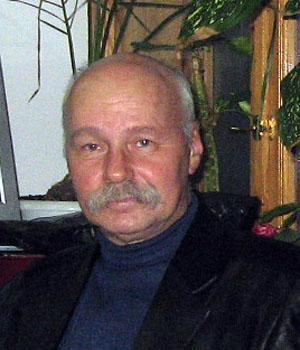
GORBATENKO VLADIMIR MIKHAILOVICH
Deputy Head of Department
Phone. +38(057) 700-05-71, +38(066)493-52-88
e-mail: gorbatenko@kipt.kharkov.ua
Research interests:
physics of strength, investigation of the effect of ultrasonic treatment on the structure and mechanical properties of the structural materials for nuclear power engineering.
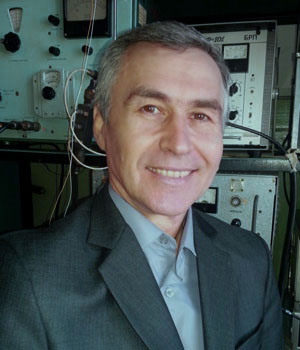
KORNIETS ANATOLIY VASILIEVICH
Acting Head of the Laboratory “Physics of Strength and Plasticity”, Researcher
PhD in Physics and Mathematics by the specialty 01.04.07 – "Solid State Physics"
Phone. +38(057) 700-26-76, +38(097) 440-18-43
e-mail: korniets@kipt.kharkоv.ua
Research interests:
X-ray, high-frequency ultrasonic (10 – 150 MHz) spectroscopy at low (78 – 300 К) temperatures: low-temperature (4.2 – 300 К) X-ray structural studies in magnetic fields up to 55 kOe; elastic and dissipative properties for a wide range of promising materials for nuclear power engineering; correlations of the anomalies for acoustic and elastic properties with the structural parameters of metals and alloys.
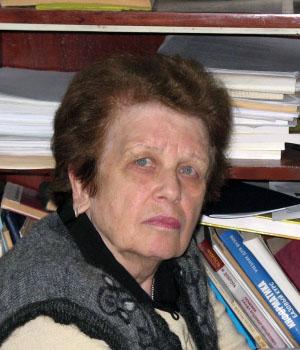
LAZAREVA MARINA BORISOVNA
Acting Head of the Laboratory "Fundamental and Applied Superconductivity, Electronic Properties of Metals", Senior Researcher
PhD in Physics and Mathematics by the specialty 01.04.07 – "Solid State Physics"
Senior Researcher
Phone. +38(057) 700-26-73, +38(067) 970-12-24
e-mail: mlazareva@kipt.kharkov.ua
Research interests:
investigation of the effects of various structural states formed with the use of large plastic deformations (at cryogenic temperatures as well) by rolling, extrusion, drawing and their combination on the physical and mechanical properties of transition metals and alloys (НF, Nb-Ti, Zr, Zr1% Nb , Al-Mg-Li); studing the interaction of hydrogen with solids.
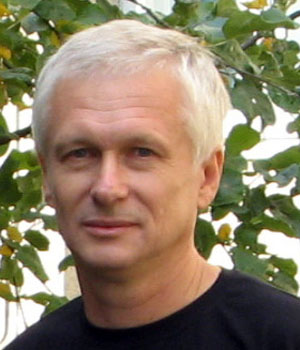
SADANOV EVGENIY VIKTOROVICH
Acting Head of the Laboratory “Crystal Physics”, Researcher, Senior Researcher
PhD in Physics and Mathematics by the specialty 01.04.13 – "Physics of Metals"
Laureate of the interdisciplinary competition for the USSR State Committee on the Utilization of Atomic Energy
Phone. +38(057) 700-26-76
e-mail: sadanov@kipt.kharkov.ua
Research interests:
field emission microscopy; theoretical aspects of solid state physics; atomic structure of defects and interfaces; electrophysical properties of reactor engineering materials; low field microscopy; field-stimulated chemical modification of the surface of metals and alloys.
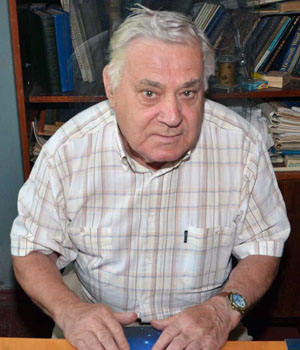
BULATOV ALEXANDER SERGEEVICH
Head of research group at the Laboratory “Crystal Physics”, Leading Researcher
PhD in Physics and Mathematics by the specialty 01.04.07 – "Solid State Physics"
Senior Researcher
Phone. +38(057) 700-26-76
e-mail: bulatov@kipt.kharkov.ua
Research interests:
X-ray, high-frequency ultrasonic (10 – 150 MHz) spectroscopy at low (78 – 300 К) temperatures: low-temperature (4.2 – 300 К) X-ray structural studies in magnetic fields up to 55 kOe; elastic and dissipative properties for a wide range of promising materials for nuclear power engineering; correlations of the anomalies for acoustic and elastic properties with the structural parameters of metals and alloys.
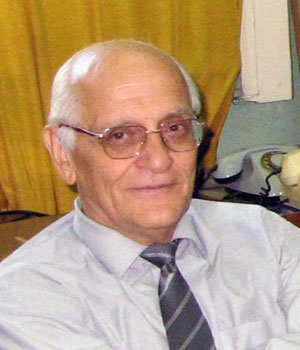
MIKHAILOVSKIY IGOR MIKHAILOVICH
Leading Researcher
D.Sci. in Physics and Mathematics by the specialty 01.04.07 – "Solid State Physics"
Professor
Laureate of the interdisciplinary competition of the USSR State Committee on the Utilization of Atomic Energy
Phone. +38(057) 700-26-76
e-mail: mikhailovskij@kipt.kharkov.ua
Research interests:
field emission microscopy; theoretical aspects of solid state physics; atomic structure of defects and interfaces; strength of nanoscale and low-dimensional systems and objects; structure of radiation defects and radiation materials science; modification of the surface of metals and alloys in strong electric fields.
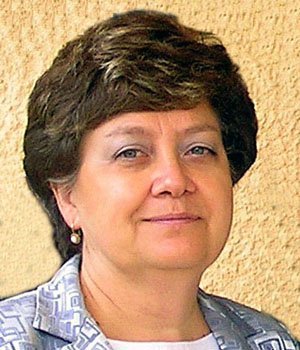
MAZILOVA TATIANA IVANOVNA
Leading Researcher
D.Sci. in Physics and Mathematics by the specialty 01.04.07 – "Solid State Physics"
Senior Researcher
Laureate of the interdisciplinary competition of the USSR State Committee on the Utilization of Atomic Energy
Phone. +38(057) 700-26-76
e-mail: mazilova@kipt.kharkov.ua
Research interests:
field emission microscopy; theoretical aspects of solid state physics; atomic structure of defects and interfaces; mathematical simulation for the structure of defects in the direct and reciprocal spaces; crystal geometric analysis of grain boundary nanotopography.
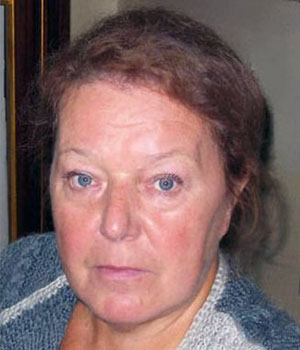
KARASYOVA EVGENIYA VASILIEVNA
Senior Researcher
PhD in Physics and Mathematics by the specialty 01.04.07 – "Solid State Physics"
Senior Researcher
Phone. +38(095) 899-79-18
Research interests:
investigation of the mechanical characteristics of the materials for nuclear power engineering, establishment of the correlation between the structural, electrophysical and mechanical characteristics of the materials under study. Studing the effects of temperature-force, radiation and magnetic fields on the creep characteristics and evolution of the structure for the structural materials of nuclear power engineering.
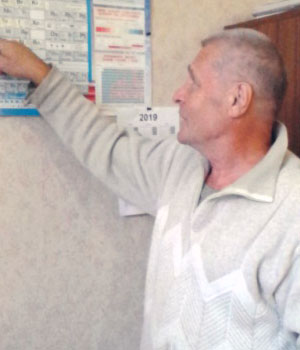
FROLOV VALERIY ALEKSEEVICH
Senior Researcher
PhD in Physics and Mathematics by the specialty 01.04.07 – "Solid State Physics"
Phone. +38(095) 899-78-34
Research interests:
investigation of the electrophysical characteristics for the structural materials of nuclear power engineering, high-entropy alloys, high-temperature superconductors. Studying the influence of various effects on the evolution of material structure in various structural states.
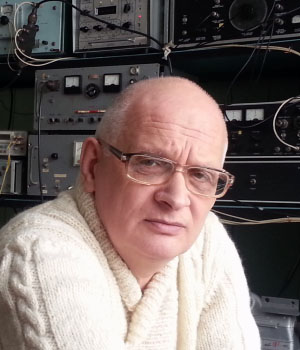
KLOCHKO VLADIMIR SERGEEVICH
Researcher
PhD in Physics and Mathematics by the specialty 01.04.07 – "Solid State Physics"
Phone. +38(097) 265-19-55
e-mail: klochko@kipt.kharkiv.ua
Research interests:
high-frequency ultrasonic (10 – 150 MHz) spectroscopy at low (78 – 300 К) temperatures; elastic and dissipative properties for a wide range of materials for nuclear power engineering; correlations of the anomalies for acoustic and elastic properties with the structural parameters of metals and alloys.
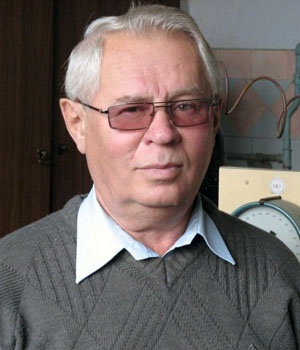
VINOKUROV EDUARD ISAAKOVICH
Researcher
Phone. +38(057) 700-24-98, +38(095) 425-84-52
e-mail: e.vinokurov@kipt.kharkov.ua
Research interests:
comprehensive study on the technological characteristics (mechanical strength during abrasion, aerodynamic resistance of the adsorbent layer, adsorption capacity for iodine and methyl iodide) of carbon sorbents for use in the manufacture and repair of adsorption filters for the ventilation system of nuclear power plants, investigation of the effect of impurity adsorption in air on the strength characteristics of sorbents and catalysts.
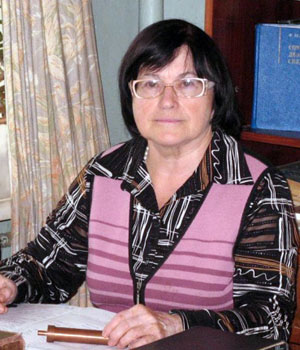
GRIGOROVA TATIANA KONSTANTINOVNA
Researcher
Phone. +38(057) 700-24-98, +38(067) 298-92-46
e-mail: e.vinokurov@kipt.kharkov.ua
Research interests:
comprehensive study on the technological characteristics (mechanical strength during abrasion, aerodynamic resistance of the adsorbent layer, adsorption capacity for iodine and methyl iodide) of carbon sorbents for use in the manufacture and repair of adsorption filters for the ventilation system of nuclear power plants; investigation of the activation effect on the specific surface of materials of various types.
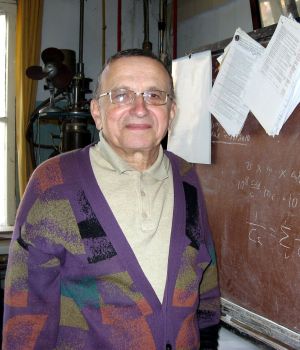
LEDENYOV OLEG PAVLOVICH
Researcher
Phone. +38(057) 700-24-98
e-mail: ledenyov@kipt.kharkov.ua
Research interests:
low-temperature physics; electronic properties of metals; superconductivity; granular media and kinetic processes in them.
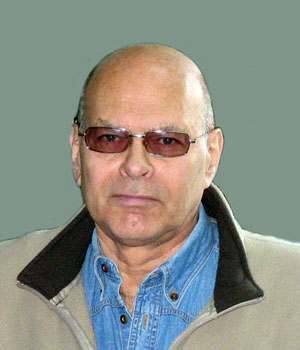
OKOVIT VLADIMIR STEPANOVICH
Researcher
Phone. +38(099) 284-33-10
Research interests:
investigation of the effect of various mechanical and thermal treatments on the dissipative and mechanical properties of metals and alloys in a wide temperature range.
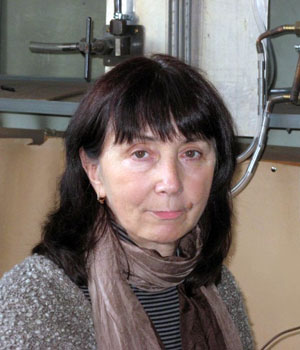
SIBILEVA RIMMA MIKHAILOVNA
Researcher
Phone. +38(057) 700-24-98, +38(068) 888-93-80
e-mail: e.vinokurov@kipt.kharkov.ua
Research interests:
comprehensive study on the technological characteristics (mechanical strength during abrasion, aerodynamic resistance of the adsorbent layer, adsorption capacity for iodine and methyl iodide) of carbon sorbents for use in the manufacture and repair of adsorption filters for the ventilation system of nuclear power plants; investigation of the adsorption effect for the impurities in air on the strength characteristics of sorbents and catalysts.
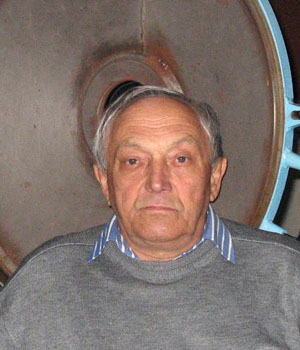
CHERNYAK NIKOLAY ALEKSEEVICH
Researcher
Phone. +38(068)-358-56-03
Research interests:
investigation of the influence of thermomechanical and radiation effects on the magnetic characteristics of ferromagnetic materials in nuclear power engineering.
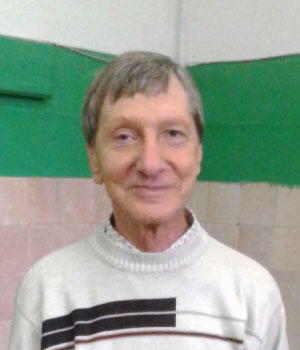
CHUPIKOV ANATOLIY ALEXANDROVICH
Researcher
Phone. +38(095)-825-54-79
e-mail: anchup@kipt.kharkov.ua
Research interests:
investigation of the electrophysical and thermophysical properties for structural and functional materials; studying the processes of hydrogen interaction with solids.